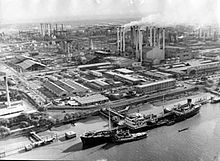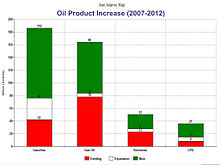- National Iranian Oil Refining and Distribution Company
-
 Iran's Abadan Refinery, built 1913.
Iran's Abadan Refinery, built 1913.
National Iranian Oil Refining and Distribution Company (NIORDC) is part of the Ministry of Petroleum of Iran. NIORDC was established on March 8, 1992 and undertook to perform all operations relating to refining and distribution of oil products.
Although NIORDC was formed in the 1990s, the company has actually inherited 90 years of Iran’s oil industries' experiences in the fields of refining, transfer and distribution of oil products, as well as, engineering and construction of installations of oil industries.
Contents
Responsibilities and duties (2009)
- Refining crude oil and producing a variety of oil products.
- Transferring crude oil from production bases and “Khazar Terminal” to the refineries and also transferring oil products from refineries and import bases to distribution procurement depots and distribution centres.
- Performing all refining projects and schemes, transfer and storing.
- Production, transfer and distribution of 250 million litres of oil products per day.
- Daily export of around 60 million litres of oil products abroad via oil terminals.
- Providing different sectors – industry, agriculture and power plants – with fuel and feed regularly e.g. petrochemical complexes.
- Providing consuming fuel to residential sector, business sector in urban and the peasantry communities all over the country.
- Providing more than 7 million vehicles – heavy and light – in the transportation sector with their required daily fuel.
Installations and capabilities
See also: National Iranian Petrochemical CompanyAs at 2010, NIORDC has 19 subsidiaries and affiliated companies, including 9 oil existing refineries.[1] Between 2007 and 2012, oil refining capacity for crude oil and gas condensate will increase from 1,600,000 barrels per day (250,000 m3/d) to 3,300,000 barrels per day (520,000 m3/d).[2] By 2009, Iran had a total refining capacity of 1,860,000 barrels per day (296,000 m3/d).[3]
Crude Oil Refining capacity (2009)[4] (in process of being upgraded)[5] Refinery Installed Capacity (bbl/d) Abadan 350,000 Isfahan 280,000 Bandar Abbas 230,000 Tehran 220,000 (Euro 5 compliant by 2012)[6] Arak (Shazand) 170,000 Tabriz 100 Kermanshah 40 Shiraz 30 Lavan Island 30 Total: 1.45 Mbbl/d (231,000 m3/d). Present Refinery Products - 2007[7] Oil Products KBPD (thousand barrel per day) Percent Gasoline 283 17% Gas oil 511 32% Kerosene 136 8% Fuel oil 457 29% LPG 50 3% Others 184 11% Other facilities:
- Fourteen thousand kilometers of crude oil and oil product transfer pipelines.
- 150 pumping stations.
- Oil industry telecommunication network.
- Operational zones for pipelines and telecommunication.
- 35 operational zones for NIOPDC.
- 220 operational areas for NIOPDC.
- Storage tank installations with 10 milliard litre capacity (2009).[8] As at 2010, the storage capacity of oil products in the country is around 11.5 billion liters, but it will reach 16.7 billion liters by the end of the Fifth Five Year Development Plan (2010-2015).[9]
Fuel imports
See also: 2007 Gas Rationing Plan in Iran, Smuggling in Iran, and Sanctions against IranIn 2008 Iran has imported nearly 40% of its market needs because of lack of refining capacity and contraband.[10] In 2009, Iran spent paid $11 billion on imported fuel.[11] In 2010, gasoline import declined to 30% of its market needs at 25 million liters of gasoline and 11 million liters of diesel fuel per day.[12][13]
As of July 2010, Iran produces between 280,000 barrels (45,000 m3) and 285,000 barrels (45,300 m3) of gasoline a day and until recently had acquired the remaining 30 percent, which is about 115,000 barrels per day (18,300 m3/d) to 120,000 barrels per day (19,000 m3/d), through big oil companies.[14]
Major gasoline suppliers to Iran historically have been India, Turkmenistan, Azerbaijan, the Netherlands, France, Singapore, and the United Arab Emirates.[15][16] The Financial Times reported that Vitol, Glencore, Trafigura and other (western) companies had since stopped supplying petrol to Iran because of international sanctions.[17] In 2006, Vitol, a MNC based in Switzerland, supplied Iran with 60% of its total gasoline cargo imports.[18] In September 2010, Iran claimed that it has stopped importing gasoline according to the domestic capacity expansion plans.[19]
Iran: Company (Country) Source of Gasoline Imports[20] 2008 2009 BP (UK) CNPC (China) ENOC (UAE) Glencore (Switzerland) Glencore (Switzerland) IPG (Kuwait) IPG (Kuwait) Litasco (Russia) MEP (UAE) Petronas (Malaysia) Reliance Industries (India) Reliance Industries (India) Shell (Netherlands) Shell (Netherlands) SPC (Singapore) Total (France) Total (France) Trafigura (Switzerland) Trafigura (Switzerland) Vitol (Switzerland) Vitol (Switzerland) Zehnua Oil (China) New facilities
See also: Iranian Economic Reform PlanAfter completion of 7 new refineries and improvement to the existing refineries at a cost of $26 billion; along with the implementation of the subsidy reform plan to cut demand, it is possible that Iran will cease being a gasoline importer by 2010-2011 and will become a net exporter by 2013-2015.[21][22][23][24]
New Planned Refineries by the public sector (as at 2010) Refinery Location Refining capacity[25] Estimated costs [26] Completion date[26] Khuzestan refinery (privately owned) Arvand Free Zone, near Abadan 180,000 barrels per day (29,000 m3/d). The refinery will refine the heavy crude oil produced in Azadegan and Yadavaran oil fields. It will also produce 10 million liters of super gasoline complying with Euro IV standard, 12.6 million liters of diesel oil, 3 million liters of jet fuel, five million liters of liquefied gas, and 440 tons of sulfur. 2.9 billion euros 2012 The Persian Gulf Star refinery Assalouyeh 360,000 of gas condensates per day and to produce gasoline, jet fuel, and other valuable products. 2.5 billion euros 2010 Shahriar refinery Tabriz 150,000 barrels per day (24,000 m3/d); gasoline production: 70,000 barrels per day (11,000 m3/d) 1.2 billion euros 2012 Anahita refinery Kermanshah Province 150,000 barrels per day (24,000 m3/d) 1.3 billion euros 2012 Hormoz refinery Bandar Abbas 300,000 barrels (48,000 m3) of heavy and extra heavy crude oil $4.3 billion 2012 Caspian refinery Gorgan, Golestan Province 300,000 barrels (48,000 m3) of crude oil; 20 million liters of gasoline, 11 million liters of gas oil from Caspian Sea countries with exports to Turkey, Afghanistan and Pakistan $4 billion 2013 Pars refinery Shiraz 120,000 barrels per day (19,000 m3/d) 800 million euros 2012 New Planned Refineries by the private sector (as at 2010)[27] Refinery Location Refining capacity Estimated costs Completion date Yasouj refinery Yasouj 150,000 barrels per day (24,000 m3/d). The refinery will produce petrol, gasoil, kerosene, furnace oil, liquefied gas, asphalt, and sulfur.[28] $2.2 billion 2014 Policy
- Providing desirable fuel supplying services and supplying feed of industries and factories all over the country in due time.
- Reducing consumption rate through employing energy consumption management and raising export rate to make foreign currency.
- Reducing waste materials through improving efficiency in refining and distribution system.
- Reducing environment pollution to reach stable development.
- Raising human force productivity and promoting level of training.
- Increasing output of refinery facilities and transfer are distribution of oil products.
- Reducing cost of production, transfer and distribution of oil products.
Subsidiary companies
The NIORDC subsidiaries are as follows:
- National Iranian Oil Products Distribution Co.
- Management of Construction & Development of "CNG" Stations Co.
- National Iranian Oil Engineering and Construction Co. (NIOEC)
- Oil Pipeline and Telecommunication Co.
- Oil Refining Co.
See also
- Petroleum industry in Iran
- Abadan Refinery
- List of oil refineries
- 2007 Gas Rationing Plan in Iran
- Ministry of Petroleum of Iran
- National Iranian Oil Company
References
- ^ http://niordc.ir/index.aspx?siteid=77&pageid=359
- ^ http://en.niordc.ir/index.aspx?siteid=77&siteid=77&pageid=963
- ^ http://www.bp.com/liveassets/bp_internet/globalbp/globalbp_uk_english/reports_and_publications/statistical_energy_review_2008/STAGING/local_assets/2010_downloads/statistical_review_of_world_energy_full_report_2010.pdf
- ^ http://www.eia.doe.gov/emeu/cabs/Iran/Oil.html
- ^ http://www.shana.ir/162624-en.html
- ^ http://presstv.com/detail/177768.html
- ^ http://en.niordc.ir/index.aspx?siteid=77&siteid=77&pageid=963
- ^ http://www.presstv.com/detail.aspx?id=108259§ionid=351020103
- ^ http://www.presstv.com/detail/156258.html
- ^ http://www.presstv.com/detail.aspx?id=107132§ionid=351020103
- ^ http://www.presstv.com/detail.aspx?id=107132§ionid=351020103
- ^ http://www.washingtonpost.com/wp-dyn/content/article/2010/06/23/AR2010062303770.html
- ^ http://www.payvand.com/news/10/jun/1083.html
- ^ http://www.presstv.com/detail.aspx?id=136026§ionid=351020103
- ^ http://fpc.state.gov/documents/organization/107234.pdf
- ^ http://online.wsj.com/article/SB122654026060023113.html?mod=googlenews_wsj
- ^ http://www.google.com/hostednews/afp/article/ALeqM5g8F5PBdgqqF_rE10ZY088CBvTqdg
- ^ http://fpc.state.gov/documents/organization/107234.pdf
- ^ http://www.payvand.com/news/10/sep/1269.html
- ^ http://www.eia.doe.gov/emeu/cabs/Iran/Oil.html
- ^ http://www.zawya.com/Story.cfm/sidZAWYA20090103051557/Iran%20to%20Become%20Gasoline%20Exporter%20by%202013%20
- ^ http://www.presstv.com/detail.aspx?id=136026§ionid=351020103
- ^ Iran daily: New Refineries Planned
- ^ http://presstv.com/detail.aspx?id=136510§ionid=351020103
- ^ http://www.payvand.com/news/08/dec/1157.html
- ^ a b http://niordc.ir/index.aspx?siteid=77&siteid=77&pageid=980
- ^ http://www.turquoisepartners.com/iraninvestment/IIM-Nov10.pdf
- ^ http://www.tehrantimes.com/index_View.asp?code=228488
External links
- Videos
- Iranian Gasoline Production Plan (PressTV video)
 Energy in Iran
Energy in IranOil 
Gas National Iranian Gas Company · Persian LNG · Gas reserves · South Pars Gas Field · Gas Exporting Countries ForumGasoline National Iranian Oil Refining and Distribution Company · 2007 Gas Rationing Plan in Iran · Fuel smugglingPetrochemicals Pipelines Tabriz–Ankara · Korpezhe–Kurt Kui · Dauletabad–Sarakhs–Khangiran · Iran–Pakistan–India · Neka–Jask · Iran-Armenia · Gas Trunkline · Persian · NabuccoNuclear Wind See also Ministry of Energy · Ministry of Petroleum · Petroleum industry in Iran · Environment · Caspian Sea · Strait of Hormuz · Kharg Island · List of power stations · Reservoirs and dams · Transport · Privatization (MAPNA · AZAR AB · IDRO) · Construction (Khatam al-Anbia · SADRA · ISOICO · DESA - Iran Heavy Diesel Manufacturing Company) · Foreign direct investment · Economy of Iran · Subsidy reform plan · Oil Stabilization Fund · Sanctions against Iran · Energy superpower · Anglo-Persian Oil CompanyCategories:- Oil and gas companies of Iran
Wikimedia Foundation. 2010.


